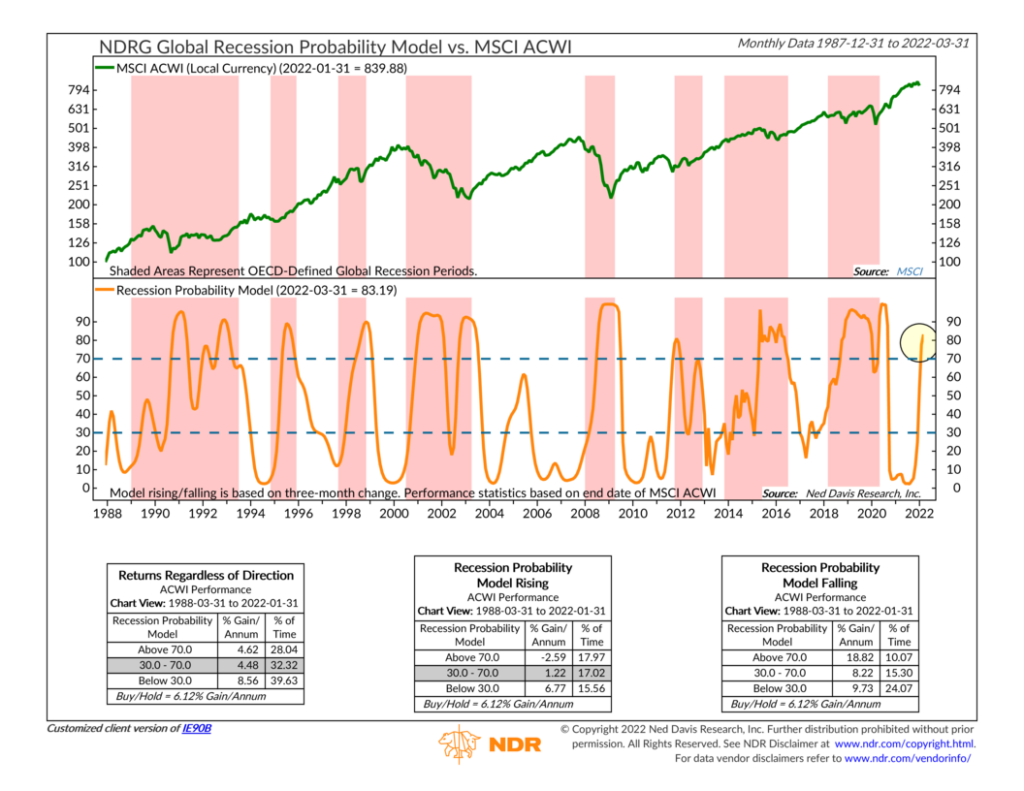
As with most things, recessions are a hard thing to predict. But, the good news is we have tools at our disposal that help us better understand when global economic slowdowns are occurring.
Specifically, we utilize a global recession probability model, shown in the chart above. The purpose of the model is to identify when global slowdowns are occurring, as defined by the OECD. To do this, the model takes the trend and level data from the Composite Leading Indicators (CLIs) of 35 of the world’s major economies, runs a statistical method called a logistic regression on this data, and then spits out a score between 0 and 100, with a higher number reflecting a higher risk of recession and vice versa.
Each of the CLIs for the different countries contains a wide range of economic indicators, such as money supply, business and consumer sentiment surveys, manufacturing production, and stock prices. When combined, these CLIs form the basis of the global recession probability model.
Historically, we’ve found that a score above 70 indicates a high risk of recession, while a score below 30 means a global recession is less likely. Glancing at the chart, you can see that, on average, the model (orange line) usually bottoms and starts rising shortly before an OECD-defined global recession begins (red shaded areas).
However, more interesting for investors is how changes in the global recession probability model translate to returns for the global stock market, represented by the MSCI ACWI index on the top of the chart.
Historically, as expected, returns tend to be the worst when the model is rising. Global stock returns get progressively worse as the model goes from below 30, to between 30 and 70, and finally above 70. When rising and above 70, global stock market returns have, in fact, been negative.
But, once the model reverses and starts falling after reaching the high-risk zone of above 70, this has been the sweet spot for stock returns, with gains upwards of 18%, on average. From there, as the model falls back below 70, the returns get lower but are still higher than average, a sign that the global economy is recovering and set to grow at an above-trend rate.
What is the model telling us now? Interestingly, it jumped into the high-risk zone (above 70) for the month of February, indicating an elevated risk that the global economy has embarked on a worldwide slowdown.
Stocks have certainly struggled so far this year, so it seems that we perhaps are indeed experiencing a global slowdown in economic growth.
To some degree, this was inevitable, as it would be extremely difficult to replicate the reopening rebound of 2021. Whether this potential slowdown is ultimately moderate and short-lived remains to be seen. That seems likely. But we’ll certainly be looking for the global recession probability model to peak and rollover since that has historically been the best zone for global stock market returns.
This is intended for informational purposes only and should not be used as the primary basis for an investment decision. Consult an advisor for your personal situation.
Indices mentioned are unmanaged, do not incur fees, and cannot be invested into directly.
Past performance does not guarantee future results.
